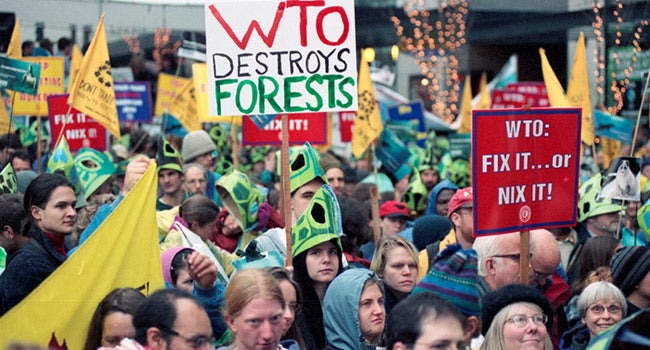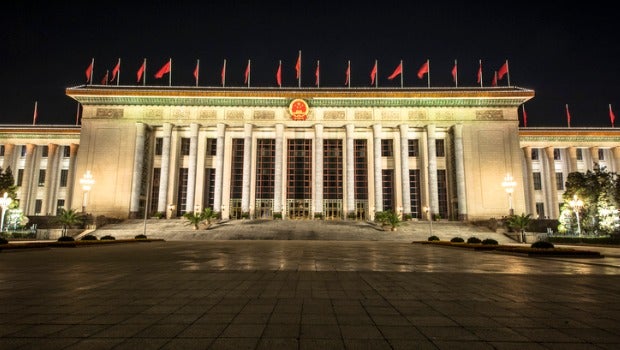The Pentagon calls it a threat multiplier. Among some academics, it’s a stressor. In 2011, millions of Egyptians and Syrians knew it simply as hunger.
By any name, climate change is contributing not just to melting ice caps and rising sea levels, but also to drought, food shortages and, ultimately, to global instability. Indeed, climate change sparked deadly food riots in 23 countries around the world between 2007 and 2012. Ultimately it even triggered what has become known as the Arab Spring when Russia, fearing its own food riots, cut off wheat exports.
As illustrated by these and other experiences around the world, humanity’s future hinges in large part on our ability to feed a growing and increasingly urban population amid variable and extreme weather conditions. Producers, consumers, governments and businesses all have an important role to play — and a responsibility to take action, right now.
Food production affects climate change, and climate change affects food production. Converting forests, grasslands, wetlands and other natural habitats to grow crops, farm fish and raise livestock releases carbon into the atmosphere. The land that remains does a significantly poorer job reabsorbing all that carbon. And as we have seen in China and Syria, not to mention California and the Midwest, climate change is driving weather events that make producing food significantly more difficult and expensive. Droughts are particularly problematic because 70 percent of the world’s fresh water consumed by humans is currently used to produce food.
All told, 7.3 billion people today use up 150% of what the Earth’s natural resources can supply. Our consumption is outpacing the planet’s renewable productivity by about 50 percent. By 2050, the world’s population will exceed 9 billion and the demand for food will roughly double. To meet that demand, we must double net food availability by 2050. And we need to understand that climate change will make this task that much more difficult.
There is no silver bullet. We need to work simultaneously on increasing productivity and efficiency while reducing waste and consumption. For each calorie we produce, we must use less land, water and energy, discharge less fertilizer, pesticide and greenhouse gas, and squander less of what we grow. Indeed, to that last point, we waste one in three calories globally or about 1.3 billion tons of food each year. That’s four times the amount needed to feed the 800 million people who are malnourished or about half of all the additional food that we will need to feed everyone by 2050.
Climate change means crop change. Producers will not be able to grow the same crops their ancestors did, year in and year out. In the next three to five years, producers will focus on increasing the efficiency of what they are producing today. However, in the medium term, just six to 10 years, they will find that climate-induced stress will increase the impact of disease and pests and they will either need to find new planting materials or switch crops altogether. This is easier said than done — particularly for people who are already invested in perennials, such as tree crops, which require significant time to reach peak productivity.
In some instances, climate shifts will make areas more productive and therefore better suited for new crops. For producers who can afford to buy new land or hire consultants to help them figure out their next move, this is an inconvenience, but not the end of the world. For poorer, smaller producers who are already farming small and often marginal pieces of land, this could be an insurmountable problem. We have already seen that climate change is increasing stress and disease for a number of crops including coffee in Central America, cocoa in West Africa and citrus in the U.S. and Brazil.
To help producers adapt, we need to keep all possible options on the table. What is acceptable will likely vary from one producer to another, one country to another or one consumer to another.
When it comes to genetics, the question is not “if” but “which.” Climate change and climate smart agriculture in response to it will warrant the use of genetics and marker-assisted breeding to increase productivity, improve drought tolerance and increase disease resistance. (Marker-assisted breeding lets farmers analyze DNA to identify favorable traits and use that information to guide planting and husbandry.)
But the impacts don’t stop there. When terrestrial producers increase acreage onto more marginal areas and increase their use of fertilizer, pesticides and irrigated water, runoff increases as well. And these materials flow into rivers, lakes, bays and oceans, causing stress in marine ecosystems including increasing coral bleaching at lower water temperatures. Rising temperatures and ocean acidification further threaten marine life, disrupting economies and communities that rely on seafood for commerce and food security.
Climate change affects more than just yields; it affects the health of the land itself. It took soil moisture levels up to three years to recover from the 2012 drought in the Midwest. When there are two years of drought in a row it can take five to 10 years to recover. In the meantime, when the soil is dryer, the organic matter and nitrogen can become volatile resulting in increased greenhouse gas emissions. It also means that producers have to work harder to rebuild their soils. In California, now in its fourth year of drought, there is simply not enough water to keep perennials like almonds and grapevines alive (much less productive) in many areas. While this is now considered a severe drought, it is not known how common this will be in the future and whether it will affect other areas around the world like California that produce a disproportional amount of the food we all depend on.
In a world where food production is increasingly affected by weather variability, trade will become an important fixture of any successful food security strategy. Increased and shifting global consumption levels will complicate these efforts. Since 2000, international food trade has more than doubled from six to 12 to 15 percent of food produced. Just eight countries dominate this trade, exporting about 65 percent of the world’s cereal grains and 85 percent of oil seeds. While they have demonstrated that they can produce the surplus needed to fill global food gaps, they are still vulnerable to climate change. In 2012, four of the eight countries experienced drought, and global food reserves reached an all-time low.
Some 100 companies touch 25 percent of global trade for 15 key commodities. Working with them and other stakeholders, World Wildlife Fund has helped define standards and metrics for more sustainable practices that measurably improve the production of crops such as oil palm, sugar, soy, and wild-caught and farmed seafood. Other efforts like the Global Roundtable for Sustainable Beef are underway to boost more sustainable production of other commodities.
WWF has developed risk assessment tools to work with companies on their supply chains as well as with financial institutions to assess risks in their supply chains and finance decisions based on environmental and social data for commodities as diverse as Brazilian soy and Vietnamese coffee. These tools will help companies anticipate risk and support or encourage climate-smart agriculture. But it is the producers on the ground that need options. They are the first line of defense.
Household names like Unilever, McDonald’s and Coca-Cola, among many others, have made time-bound commitments to buy products from suppliers that produce based on credible standards. However, even these companies have limited power to change behavior across the global food industry as most food is still produced and consumed locally. These companies can move the top performers that are already exporting products, but the bottom performers are accountable for more than their share of the problems. For any commodity, about one quarter of producers are responsible for about half of the environmental impacts but only 10 percent of production.
To reduce the key environmental impacts of food production while producing more food and addressing the impacts of climate change, we need to shift our focus from recognizing the top producers to moving the ones on the bottom. The lessons learned from the better producers can guide producers on the low-performing end of the spectrum. And governments will have to play a role here to define what is acceptable and to encourage continuous improvement through extension and linked to finance
Globalization is real. Human behavior in one corner of the planet affects biodiversity in another. The cumulative effects of our consumption of natural resources — food, water, land, energy — are yielding increasingly negative results. From drought-ridden California to war-torn Syria and Ukraine, we can see the interplay and impact of food insecurity, climate change and the global grab of resources on the evening news.
Indeed, we can see that our climate isn’t the only thing that is changing; social and political forces including income distribution, consumption and urbanization are shifting quickly as well. This rate of change means that there is never going to be a blueprint that can tell producers exactly what to think. Rather, the issue is how to think. Whatever is a better practice today will become the norm tomorrow and what we need to fix the day after.
Producers, consumers, financial institutions, the scientific community and the world’s most powerful food companies all share a responsibility to tackle these challenges now before acute problems become chronic and more difficult to address. All food stakeholders must answer the $100 billion question: how can they leverage growing demand for sustainably produced goods — worth about $100 billion each year — to generate investment into more sustainable production systems? But producers will bear the brunt of these efforts. The question is what can the rest of us along the value chain do to anticipate the changes needed, rather than lurch from crisis to crisis by country or commodity? We need a more agile global food production system that can keep pace with or, ideally, anticipate and stay ahead of climate change and its chaotic byproducts. From this point on, the cost of inaction will only grow.


